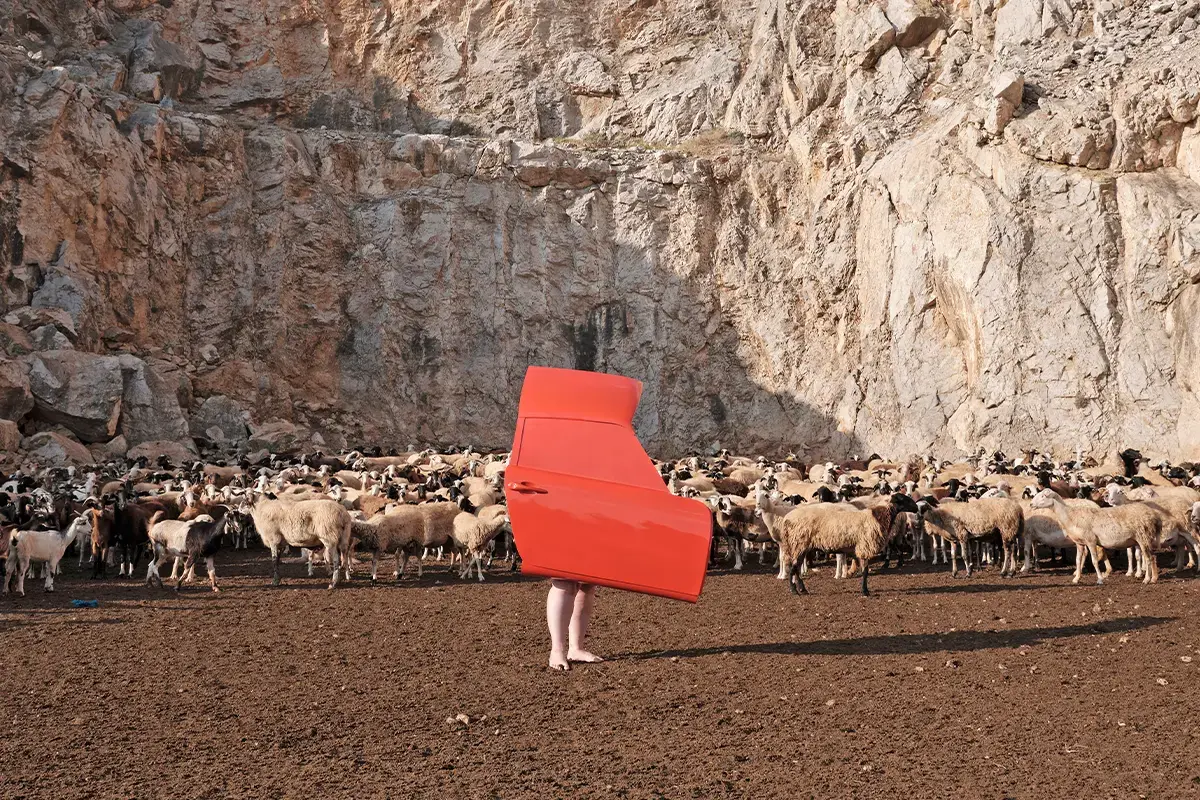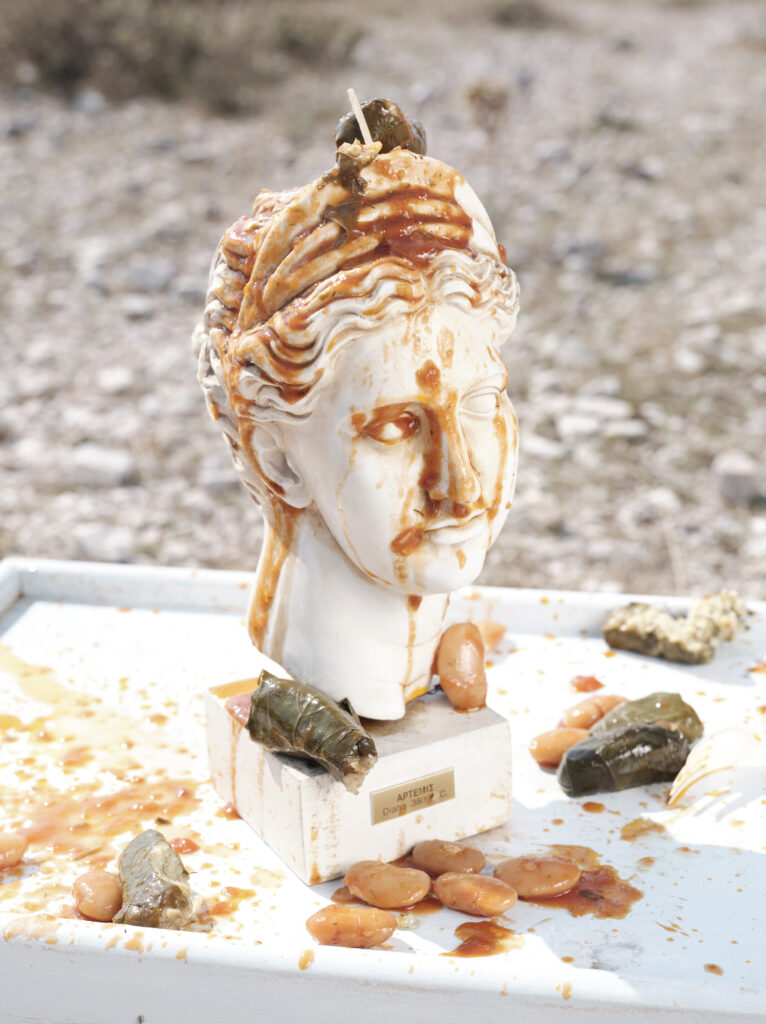British artist Jeremy Hutchison and Belgian curator Evelyn Simons present The Never Never, second chapter of Driftwood, or how we surfaced through currents (2017) supported by Fondazione Prada
Lampoon introduces Jeremy Hutchison and Evelyn Simons
The collaboration between British artist Jeremy Hutchison and Belgian curator Evelyn Simons started in 2017 when Simons received a grant from Fondazione Prada and Qatar Museums. This allowed her to curate Driftwood, or how we surfaced through currents, a group exhibition across the Athenian district of Exarchia.
«I was keen to explore how I could initiate an art exhibition outside the walls of an institution; operating in public space. This mostly came from a curiosity towards spectatorship, a desire to present contemporary art to people who weren’t quite expecting it. I came across Jeremy’s work, which I felt pushed the right buttons. His practice, very much embedded within a research on media consumption, stemming also from his background in marketing, triggered a lot of the thinking process for the exhibition as a whole», Simons explains.
Given that her curatorial activity centers around social practice and art in public space, she found in Hutchison’s interrogation of media and consumerism a vehicle to investigate new modes of display within social contexts.
Driftwood, or how we surfaced through currents (2017), Athens
Driftwood, or how we surfaced through currents stemmed from Simons’ surprise with how the worlds of contemporary art and mass media engaged with the refugee crisis. At the time, this was reaching its peak at Europe’s borders, and the media coverage was intense, but polarised. «I was actually quite shocked to see all these exhibitions popping up, reacting to this humanitarian crisis with a lot of self-contempt while completely lacking impact. The exhibitions were often made by and for people who were never affected, and its money circulated purely within the same circles of power and elitism. It all felt rather hypocritical, so I was more interested to address these double standards in which we’re all so complicit. To me, it felt more important to depart from my own position as a white privileged art curator, and to acknowledge the freedom I hold as a European to travel and initiate an ambitious exhibition abroad. Driftwood in consequence talked about the discrepancies between the stimulated circulation of commodities, and the restricted circulation of bodies. Within this reality, people can become commodities, and commodities can acquire the rights of people. Athens, on the frontier of ‘Fortress Europe’, and a historic crossroads in the Balkan peninsula felt like a symbolic context for this exhibition.
Hutchison’s work engaged directly with this context of Fortress Europe, and the flows of goods and services that it welcomes or prohibits: «I was thinking about borders, bodies and labour. And my research drew me to this horrific photograph taken by Balkan police. It showed a pair of Syrian refugees who were trying to cross into Europe by attempting to disguise themselves as car seats».
For Hutchison, this image spoke to the barbarity of a geopolitical regime that privileges the movement of objects over the free movement of human beings. He responded with Movables; a series of photo collages that blend human bodies with car seats. These anthropomorphic hybrids are both absurd and deeply unsettling. They speak to his interest in the relationship between bodies and things, and the political implications of this fusion: «Under the logic of neoliberalism, subjects are obliged to behave as objects, and objects to behave as subjects. I think there’s a nightmarish comedy about this scenario».
The second chapter: The Never Never
«After we presented the first exhibition, I hadn’t depleted the entire grant yet, so I agreed with Fondazione Prada to do a follow-up project in Athens. I reached out to Jeremy, and our discussion evolved in a way that was fruitful, inspiring and thought-provokingly funny. I understood that this collaboration, again, would also challenge my curatorial practice. We both wanted the process to be as important as the outcome: so the whole conception and production of The Never Never became a sort of a performative happening», Simons explains. It resulted in a complex body of work, produced by an international crew of twenty-five people.
The Never Never thus comprises multiple elements and artistic languages: a short film (the core of the project) alongside photographs, billboards, performance and sculpture. In this work, a Porsche 911 is divided into eight parts and worn by Athenian performers. Like hybrids from ancient mythology, these farcical creatures emerge from the sea, navigate a series of epic landscapes before arriving at a photo studio. In doing so, this work carries echoes of Movables, Hutchison’s previous work. Using a nonsense language of anthropomorphic hybrids, it critically engages with the seductive myths of the mass media.
Capitalism and national stereotypes
The title of this work is slang for debt. Putting a purchase ‘on the never never’ conveys the idea of an endless deferral, as Hutchison explains. «Our culture is built on debt. On the never never. Our monetary system isn’t tied to gold, but to a myth. The myth of growth for the sake of growth. And our nations, cultures, and economies are fabricated on this myth. Needless to say, this is nothing new: humans have lived under shared fantasies as long as we’ve existed», Hutchison explains. Whether in political systems or advertising, the way societies participate in collective imaginaries is a source of equal concern and fascination for the artist.
In the Never Never, he tackles this idea using a piece of disinformation that his father told him: «Did you know, there are more Porsches in Athens than anywhere else in Europe?».
«This turned out to be fake news. But for a while, it circulated around right-wing media because it’s emblematic of the suspicion and xenophobia that certain Northern Europeans hold towards Greeks. That they don’t pay taxes; that they only have themselves to blame for their economic problems; that they entered the monetary union under false pretences», Hutchison says. «We wanted to expose the absurdity of this media portrayal through an act of ludicrous over-performance».
The manipulation of brands logic and language in Hutchison’s practice
Borrowing from the codes of fashion and advertising, The Never Never reflects on the mechanisms used by contemporary brands to perpetuate their own myths. «The logic of branding is the logic of Empire. It’s difficult to differentiate between historic imperialism and how it plays out in our postcolonial world. The economist Joseph Schumpeter coined the term Objectless Expansion, to describe this process: Empire expands for the sake of expanding, and dominates for the sake of dominating», the artist explains.
This impulse applies to brands, and the reiteration of their corporate myths through the relentless aesthetics of pop culture. The Never Never aims to explore these processes, hijacking a visually-compelling language to highlight the warped ideology lurking behind the bright patina of consumer society. Rather than generating a new radical aesthetic, Hutchison relies on détournement; diverting the visual languages of pop culture to create a celebratory form of critique.
«A friend recently told me I use the tools that I hate: the manipulation of language and image, deception and seduction. I guess he’s right. The language of commerce goes very deep in me: I taught myself to read with product catalogues. In my early twenties I wrote commercials for Coca-Cola. So I identify with the consumer impulse. I think I understand why it works», he explains.
«We researched these tendencies in a trans-historical way, looking at how the objects we classify under archaeology today, were products of media and propaganda in ancient times. One of our most important brainstorms was done in the British Museum, surrounded with the looted Parthenon marbles», adds Simons.
A kind of art which draws from society
In the preparatory stages of The Never Never, she also expressed her desire to engage Athenians in the project. «It was essential for me to collaborate with local actors, making a project in, but also with Athenians. Ilektra Kalaitzaki, who produced Dritfwood with me and who became a dear friend, told me about Nova Melancholia. They seemed the perfect match: a hybrid queer theatre and performance collective, who very much research bodily gestures, and almost create a sculptural langauge in doing so». The aesthetic strategies of the Greek collective include camp and gender identities as means of queering the viewers’ experience of the work.
This humorous and playful attitude marries well with Hutchison’s own visual language who has made the transgression and subversion of social norms his trademark. In fact, it is mainly through teamwork and mutual exchange that Hutchison’s ideas take shape: «I’m interested in the anti-social function of art. How it can misbehave inside the constraints of social norms and cultural hegemony. For me, the core function of art is to mess things up; to produce a kind of nonsense which militates against the conventions of meaning. I want my work to bust through the walls – to open up strange new horizons of sense.
Curating a traveling art exhibition
Another driving force of The Never Never is the partnership with each exhibition’s institutional host. Drawing on the specific location, each show responds to a core characteristic of the city.
«Hamburg is the advertising capital of Germany, so the artwork and its publicity became indistinguishable. The exhibition as a marketing campaign; the marketing campaign meandering through the city as an exhibition. Luxembourg is one of the smallest countries in Europe – yet it is a force majeure in global banking. So that exhibition researches how scale, perception and impact are intertwined», Simons explains. Drawn to artists who engage with society (rather than pure formalism), Simons’ curatorial practice always takes its starting point from the context: the history of the site, the architectural premises, the audience of the exhibition. «I indeed need a departure point to conceive a new project. For example, I have difficulties working from the void of a white cube. What I find most thrilling, is to be very precise in my commissions towards artists, to create together in response to a specific context at a specific time. To find some magic in the encounter itself».
Hutchison and Simons wink at the art world’s system of patronage by satirically performing their own professional roles: the workaholic-narcissistic-artist and the caffeinated-networking-curator. In doing so, the project deals with artistic labor, production and funding. In this case, the funding source being Fondazione Prada. Performing its own social contradictions, The Never Never reflects on the way art is used as an instrument for industry, celebrity, commerce and culture. It explores the way art becomes a vehicle for power to narrate its own myths.
Jeremy Hutchison
British artist based in London. His institutional shows include the ICA, Modern Art Oxford, V&A, Z33, Prada Foundation, EVA Biennale, Nassauischer Kunstverein Wiesbaden. He received a distinction from the Slade School of Fine Art and was a fellow of the Whitney Museum ISP, New York. He is the founder of Kunsthallo – a project space in London.
Evelyn Simons
Curator and writer based in Brussels. She runs the visual arts and performance programming at Horst Arts & Music. She programs the artists in residence for the Fondation CAB Bruxelles and Saint-Paul-de-Vence, and acts as curator for the Collectif Ballon Rouge. She is the winner of the Curate Award, Fondazione Prada & Qatar Museums in 2014.




















